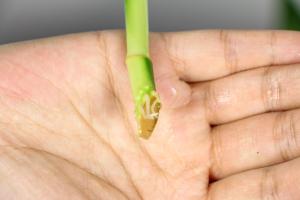Introduction
Plants are fascinating organisms that play a vital role in our ecosystem. They are responsible for producing oxygen, regulating the climate, and providing food for both humans and animals. One of the essential components of a plant is the phloem, which is responsible for transporting vital nutrients, hormones, and sugars throughout the plant body. In this article, we will explore what the phloem of a plant is, its function, and its many roles in plant growth and development.
What is the Phloem of a Plant?
The phloem is a complex tissue found in vascular plants that performs the critical function of transporting nutrients and sugars throughout the plant body. This tissue is responsible for moving sucrose, amino acids, and other essential molecules from the leaves to other parts of the plant, such as the roots, stems, and flowers. While the primary function of the phloem is transport, it also plays an essential role in plant signaling, response to stress, and growth regulation.
The Structure of the Phloem
The phloem consists of several types of specialized cells that work together to transport nutrients throughout the plant body. The two primary types of cells found in the phloem are sieve tube elements and companion cells. The sieve tube elements are long, thin cells that form the conduits for nutrient transport. The companion cells are smaller and more numerous, and they help support the sieve tube elements by providing them with energy and nutrients. Together, these cells form a complex network of conduits that allows the phloem to transport nutrients efficiently and effectively.
The Function of the Phloem
The primary function of the phloem is to transport nutrients and sugars throughout the plant body. This process is driven by a pressure gradient that is created by the movement of water into the phloem tissue. When sugar molecules are loaded into the sieve tube elements, they create a higher concentration of solutes in the phloem, which draws in water. As the water moves into the phloem tissue, it creates a pressure gradient that allows the sugar molecules to move from areas of high concentration to areas of low concentration. The phloem is also involved in other processes, such as the regulation of plant growth and the response to stress.
The Role of the Phloem in Plant Growth and Development
The phloem plays many roles in plant growth and development. One of its key functions is to transport nutrients to the areas of the plant that need it the most. For example, during periods of rapid growth, the phloem may transport more nutrients to the growing tips of the roots and stems to help support their growth. Additionally, the phloem can transport hormones throughout the plant body, which help regulate growth, development, and response to environmental cues. The phloem is also essential during periods of stress, as it can transport protective compounds to various parts of the plant to help it cope with adverse conditions.
Conclusion
The phloem is a critical tissue in plant growth and development. It is responsible for transporting essential nutrients, hormones, and sugars throughout the plant body and plays a crucial role in growth regulation, stress response, and other essential processes. By understanding the function and structure of the phloem, we can gain a deeper appreciation for the complex and beautiful world of plants.

 how many times do yo...
how many times do yo... how many planted tre...
how many planted tre... how many pine trees ...
how many pine trees ... how many pecan trees...
how many pecan trees... how many plants comp...
how many plants comp... how many plants can ...
how many plants can ... how many plants and ...
how many plants and ... how many pepper plan...
how many pepper plan...






























